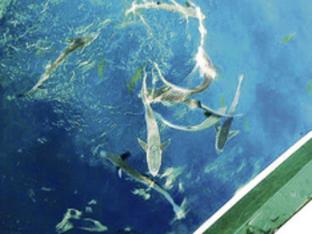Published in the Ocean Watch column, Honolulu Star-Advertiser © Susan Scott
April 11, 2011
My March 7 column about rough-toothed dolphins included a website showing photos of dolphins being studied in waters off Kauai (www.cascadiaresearch.org).
Two pictures feature a spinner dolphin leaping and spinning, with captions explaining that the dolphin was trying to remove remoras.
 ©2011 Susan Scott
©2011 Susan Scott
Two-foot-long remoras visited Susan Scott’s boat immediately after she anchored in Australian waters.
That prompted this request from Hawaii reader Peggy Frierdich: “Could you please give more information about remoras and why spinner dolphins try to dislodge them?”
With pleasure. I’m a big fan of the resourceful remoras.
Eight species of remoras, also called sharksuckers, travel the world’s oceans stuck to the exteriors of sharks, rays, turtles, whales, dolphins, manatees, billfish and ships. Remoras have also been found attached to the insides of sharks’ and rays’ mouths and in their gill cavities.
The largest remora, often attracted to sharks, grows to 35 inches long. Ancient Hawaiians called this species leleiona, and some thought it was the shark’s offspring.
A remora sticks to its ride by using an oblong disc on top of its head that creates a powerful vacuum when pressed against a surface. Remoras are not parasites. Rather, these common fish are hitchhikers, eating their hosts’ leftovers and skin parasites. Remoras might also grab a snack of passing fish or plankton.
I’m fond of remoras because twice while sailing in Australian waters, I had 2-foot-long remoras visit my boat immediately after anchoring. Curious as to whether these lively fish were sticking to my hull, and also wondering whether they would stick to me, I jumped in the water.
The remoras, however, either didn’t like my anti-fouling bottom paint or weren’t interested in a motionless boat. Nor did they care much for me, which might have been a good thing. Large remoras’ suction cups are so strong that anglers in some parts of the world tie a line around the fish’s tail and let it swim. When the remora sticks to a fish or turtle, the angler carefully hauls in the remora and its unlucky host.
We humans can break a remora’s strong suction with our hands, but dolphins don’t have this luxury. They can, however, jump like gymnasts. The question is, Do dolphins sometimes jump and spin to shake off remoras?
I asked this of Robin Baird, coordinator of the Cascadia Research Collective’s ongoing studies of Hawaii’s whales and dolphins. He emailed back, “Remoras can cause quite significant skin lesions, I think, just by long-term residence on one part of the body. … One of these lesions (which we call ‘persistent remora damage’) is shown on a spotted dolphin at www.cascadiaresearch.org/hawaii/April2010.htm.”
Baird points out that high-resolution digital cameras with fast motor drives now make it possible to see even small remoras stuck on dolphins. Because many dolphin jumpers have these hitchhikers, Baird hypothesizes that a significant proportion of spinner and spotted dolphins’ leaps are efforts to remove pesky remoras.
These sticky fish are the stuff of legends. The Romans blamed remoras for Emperor Caligula’s death, believing the fish stuck to his ship’s hull and held it back until the enemy caught up and killed him.
That notion is pretty far-fetched, but the ancients had one thing right: Like Hawaii’s dolphins, they knew that remoras suck.